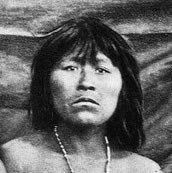The traditional territory of the Yamana, also known as Yahgan, encompassed the intricate network of islands and waterways south of Isla Grande de Tierra del Fuego (Land of Fire), extending all the way to Cape Horn. Unlike their terrestrial neighbors, the Selk'nam, the Yahgan were a nomadic, canoe-faring people, their lives inextricably linked to the sea. Their distinctive bark canoes served as their primary mode of transport and floating homes.
Yahgan men were skilled hunters of sea lions, often using heavy harpoons, while women were exceptional divers, plunging into the frigid waters to collect shellfish. This reliance on marine resources, combined with their incredible physiological adaptations, allowed them to survive in a climate that astonished early European explorers.
Despite the often subpolar conditions, the Yahgan traditionally wore little to no clothing, a practice that bewildered Europeans like Charles Darwin. They kept warm by huddling around small fires, both on land and in their canoes, and by covering their bodies with animal grease to trap heat. The very name "Tierra del Fuego" (Land of Fire) was coined by European navigators who observed the myriad fires lit by the Yahgan dotting the shoreline.
Yahgan society was typically organized into small, independent family groupings, with no centralized tribal leadership. The family, usually monogamous, served as the fundamental social, political, and economic unit. Their material culture, while seemingly simple to outsiders, was perfectly suited to their nomadic, aquatic lifestyle.
Beyond their iconic canoes, they crafted tools for hunting and gathering and practiced intricate basket weaving. Their understanding of their environment was profound, allowing them to navigate the treacherous waterways and exploit resources with remarkable efficiency.
The arrival of Europeans in the 16th century marked a tragic turning point for the Yahgan people. Initial sporadic contacts gave way to increasing interaction with seal hunters, whalers, and missionaries in the 19th century. While missionaries made efforts to learn and document the Yahgan language, the overall impact of European presence was devastating; the Old World diseases decimated the population due to epidemics of measles, smallpox, whooping cough, and respiratory illnesses. Their population, estimated to be between 2,500 and 3,000 in the mid-19th century, plummeted rapidly to just a few hundred by the turn of the 20th century and to a mere handful by the 1930s. While the Yahgan language itself is no longer spoken natively, there are ongoing efforts to preserve its vocabulary and grammar. There is a growing movement among the Yahgan community and its supporters to revitalize their cultural heritage, including traditional handicrafts like basket weaving and the symbolic reconstruction of canoes.
Today, descendants of the Yahgan live primarily on Navarino Island in Chile, particularly in the community of Villa Ukika near Puerto Williams.
Yamana women play a fundamental role in the production of handicrafts. They are experts in weaving baskets, making clothing from animal skins and making body ornaments from shells, bones, and feathers.
Religious beliefs permeated their lives, centering around a benevolent supreme deity, Watauinewa, the "master of the whole spirit world," and a host of lesser spirits and ghosts. Shamans (yékamuš) served as religious specialists and spiritual advisors. Ceremonies, such as the kina coming-of-age ritual for young men, involved masked figures and served to transmit cultural knowledge.
Some sources state that they believed in the existence of a single god, creator of the universe, while others maintain that they had no traditional religious concepts. What is clear is that their worldview was centered on nature and the interconnectedness of all living things.
The Yamana need to be recognized as Chilean citizens in order to have the opportunity to open their eyes and ears to the voice of God and, as happened with the Anglican missionaries who once came to their territory, to hear the gospel. They need to know Jesus as their Savior and understand that, more important than a cultural identity, is to have an identity in Christ.
Pray that the Yamana people will hear the gospel again and surrender their lives and circumstances to Christ.
Pray that their hearts will be open to that unique and creative God in whom their ancestors believed and who is far from empty Catholic traditions.
Pray that missionaries will come again to this village to preach the love of God.
Scripture Prayers for the Yamana in Chile.
https://costumbres.blog/indigenas/costumbres-de-los-yamanas/
https://lacgeo.com/yahgan-people
https://en.wikipedia.org/wiki/Yahgan_people
| Profile Source: Joshua Project |










